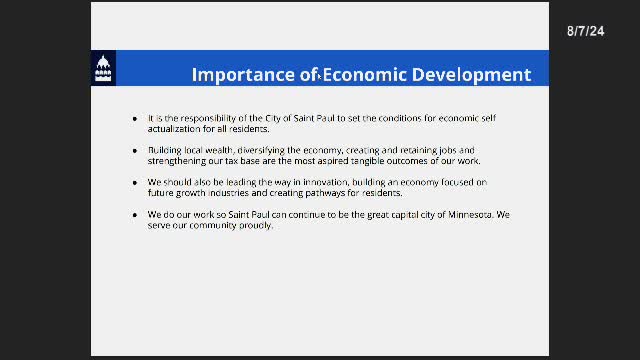City leaders launch ambitious plan for inclusive economic growth
August 07, 2024 | St. Paul City, Ramsey County, Minnesota

This article was created by AI summarizing key points discussed. AI makes mistakes, so for full details and context, please refer to the video of the full meeting. Please report any errors so we can fix them. Report an error »

In a recent government meeting, officials emphasized the importance of economic development as a means to foster self-actualization among residents of St. Paul. The discussions highlighted the need to create pathways for all individuals to participate in the economy, acknowledging that not everyone aspires to be an entrepreneur or large-scale business owner. Instead, the focus is on supporting micro-businesses and individuals who seek to define success on their own terms.
Director Lloyd underscored the significance of building local wealth, diversifying the economy, and creating sustainable jobs while strengthening the city’s tax base. The meeting outlined a strategic plan developed between February and March 2024, which involved a SWOT analysis to identify strengths, weaknesses, opportunities, and threats in the local economic landscape. This collaborative effort aimed to ensure equitable access to resources for entrepreneurs and community partners.
Key initiatives discussed included supporting local businesses through real estate and financial investments, promoting a cyclical economy where community members support local enterprises, and addressing the issue of vacant properties. The officials expressed a desire to adopt an asset-based approach to economic development, focusing on revitalizing underutilized spaces and directing resources to high-priority areas in need of attention.
The conversation also touched on leveraging technology and innovation to create sustainable job opportunities, particularly in light of advancements in artificial intelligence. Officials acknowledged the risk of leaving behind communities that may struggle to access job training and skills development in this evolving landscape.
The meeting concluded with a commitment to enhancing the business environment, increasing job creation, and preventing displacement, all while fostering a thriving and resilient city. The collaborative approach aims to ensure that all residents feel supported and empowered to contribute to St. Paul’s economic growth.
Director Lloyd underscored the significance of building local wealth, diversifying the economy, and creating sustainable jobs while strengthening the city’s tax base. The meeting outlined a strategic plan developed between February and March 2024, which involved a SWOT analysis to identify strengths, weaknesses, opportunities, and threats in the local economic landscape. This collaborative effort aimed to ensure equitable access to resources for entrepreneurs and community partners.
Key initiatives discussed included supporting local businesses through real estate and financial investments, promoting a cyclical economy where community members support local enterprises, and addressing the issue of vacant properties. The officials expressed a desire to adopt an asset-based approach to economic development, focusing on revitalizing underutilized spaces and directing resources to high-priority areas in need of attention.
The conversation also touched on leveraging technology and innovation to create sustainable job opportunities, particularly in light of advancements in artificial intelligence. Officials acknowledged the risk of leaving behind communities that may struggle to access job training and skills development in this evolving landscape.
The meeting concluded with a commitment to enhancing the business environment, increasing job creation, and preventing displacement, all while fostering a thriving and resilient city. The collaborative approach aims to ensure that all residents feel supported and empowered to contribute to St. Paul’s economic growth.
View full meeting
This article is based on a recent meeting—watch the full video and explore the complete transcript for deeper insights into the discussion.
View full meeting
